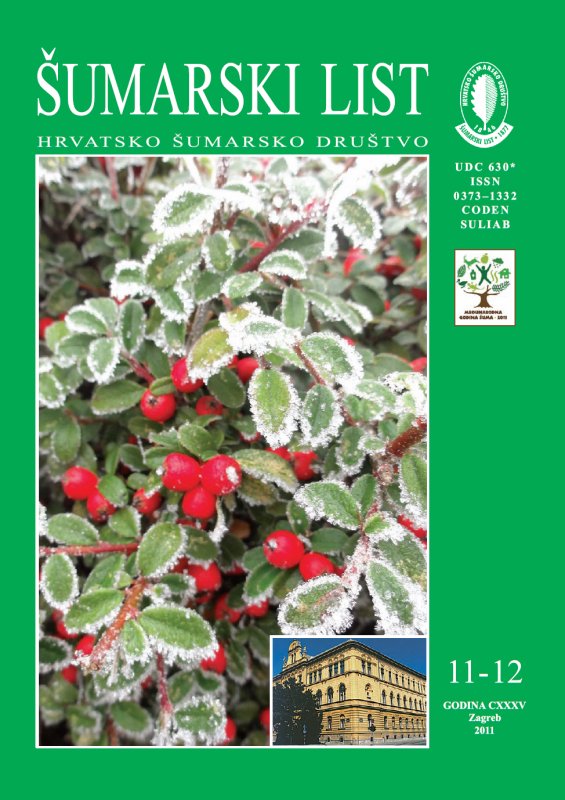
broj: 11-12/2011
pdf (7,26 MB) |
|
||||||||||||||
| RIJEČ UREDNIŠTVA | ||
| Uredništvo | ||
| AT THE END OF 2011 – THE INTERNATIONALYEAR OF FORESTS pdf HR EN | 541 | |
| IZVORNI ZNANSTVENI ČLANCI | ||
| Tančeva Crmarić, O., S. Štambuk, Z. Šatović, D. Kajba | UDK 630* 165 (Prunus avium L.) (001) | |
| Genotypic Diversity ofWild Cherry (Prunus aviumL.) in the Part of its Natural Distribution in Croatia pdf HR EN | 543 | |
| Pezdevšek Malovrh, Š., D. G. Hodges, B. Marić, M. Avdibegović | UDK 630* 923 + 946 (001) | |
| Private Forest Owner Expectations of Interest Associations: ComparativeAnalysis between Slovenia and Bosnia-Herzegovina pdf HR EN | 557 | |
| PRETHODNO PRIOPĆENJE | ||
| Grubešić, M., K. Tomljanović, S. Kunovac | UDK 630* 156 | |
| Distribution and Abundance of Rock Partridge (Alectoris graeca Meisner) in Croatia and Bosnia and Herzegovina pdf HR EN | 567 | |
| Šprem, N., M. Piria, H. Novosel,T. Florijančić, B.Antunović,T.Treer | UDK 630* 156 + 134 | |
| Morphological Variability of the Croatian Wild Boar Population pdf HR EN | 575 | |
| Stojanović,D., S.Ćurčić, S.Orlović, Z.Galić | UDK 630* 453 | |
| Noctuid Pest Species Inventory (Lepidoptera: Noctuidae) of the National Park “Fruška Gora” pdf HR EN | 585 | |
| Summary: The paper presents a part of the forest entomology inventory and pest monitoring results during the 7-year research period (2002–2008) conducted within the National park “Fruška gora” in Syrmia, Northwest Serbia. A classical approach standardized for the Macrolepidoptera monitoring programs was applied. Several light trap models were used as well as Malaise traps. Moths were also collected directly, on street lights, flowers and with wine baited traps. Species abundance, frequency af appearance and corresponding flight periods was obtained with the negligible impact to the fauna, complying to the standards prescribed in the areas of protected nature. Taxonomical identification of the recorded noctuid moths was done according to most relevant and recognized keys, listed in the references. In total, 55 species of potentially harmful Noctuidae species were recorded during the 7-year inventory. By the starting assumption, their harmfulness was derived from the former literature data as well as rich forest protection, defoliator outbreak history and field experience of local forestry. Out of 204 noctuids known for the area of Fruška gora, only the listed 55 (Table 1) were chosen for the purpose of this paper. Comparison with the results of the neighboring Spačva forest (Eastern Croatia) where 161 noctuid species were recorded in a multiyear research in the 1970-ies out of which 34 were categorized as potentially harmful (capable to generate outbreaks of various magnitudes). Both in the Croatian side (Spačva forest) and National Park “Fruška gora” species from the subfamily Hadeninae and Noctuinae were dominating noctuids. For all the listed species, place and date of the first record is given, their flight period, food plant and observed frequency (given as number of specimens in various number classes – Table 1). It is concluded that, during the monitoring period none of the recorded species caused damages that could be categorized as harmful for the tree species of their corresponding food plants. Key words: Lepidoptera; National park “Fruška gora”; Noctuidae; nouctuid moths; pests | ||
| STRUČNI ČLANCI | ||
| Lovrić, M., S. Krajter, M. Landekić, Ž. Zečić, N. Lovrić, D. Vusić, I. Martinić, M. Šporčić | UDK 630* 327 + 362 | |
| Development and Reprecutions of EU Legislation Related to Illegal Logging pdf HR EN | 595 | |


